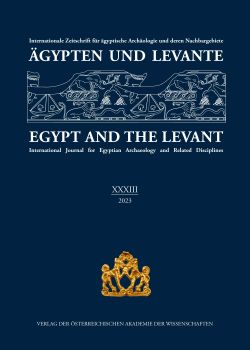Manfred BIETAK (Editor in Chief) - Ernst Czerny - Christiana Köhler - Nadine Moeller - Karol Myśliwiec (Eds.)
Ägypten und Levante XXXIII
Egypt and the Levant XXXIII
Internationale Zeitschrift für ägyptische Archäologie und deren Nachbargebiete
International Journal for Egyptian Archaeology and Related Disciplines
Eman Khalifa
S. 311 - 322
doi:
10.1553/AEundL33s311
Verlag der Österreichischen Akademie der Wissenschaften
doi:
10.1553/AEundL33s311
Abstract:
This paper examines an unpublished Egyptian black-topped pot lacking a clear context to prove its legitimacy, authenticity, acquisition process, and date. These objectives were achieved by conducting a brief technological analysis of the firing techniques and explaining the complex nature of black-topped pottery production inside and outside of Egypt using experimental archaeology. This was done in addition to checking the dealer’s background and explaining the circumstances of its acquisition. The pot was also dated through a morphological comparison with other dated parallel examples. Based on its form, this article dates the museum piece to Naqada IC-Naqada IIA. To present the pot within its broader social context, the article also offers an overview of the period to which it belongs. The general final discussion explains that the pot’s features—specifically the lack of polishing and slipping on the surface—can be linked to a Nubian connection. The article also explains that trade, as outlined in the text, contributes to innovation and the development of craft specialization. Hence, this piece sheds light on craft specialization and cultural transmission during NIC˗NIIA in Egypt, while also showing the limitations of applying knowledge transfer theories to museum objects. During this period, Upper Egyptian elites relied on surplus accumulated luxury items, including black-topped pottery. Recent studies, however, show that black-topped pottery was not only a luxury item but was also used to serve beer in ceremonies organized by the emerging elite. The pot’s restricted form is interpreted as evidence of the shift toward trade, aligning with previous arguments for the same period that draw on similar forms of black-topped pottery at Abydos. In other words, this type of pottery was valued for both its aesthetic beauty and its functional utility.
Black-topped pottery; Predynastic Pottery; Naqada - Pottery Studies; Ancient Egypt; Macquarie University History Museum
Published Online:
2024/02/28 15:42:21
Object Identifier:
0xc1aa5576 0x003ed9d2
Rights:All rights reserved.For questions regarding copyright and copies please contact us by email.
Die Zeitschrift Ägypten und Levante wurde im Jahr 1990 von Manfred Bietak begründet, um den Forschungen zu den Kulturkontakten zwischen Ägypten und seinen Nachbarländern sowie der ägyptisch-kanaanäischen Hybridkultur, wie sie vor allem bei den österreichischen Ausgrabungen in Tell el-Dab’a zutage trat, eine Publikationsplattform zu bieten. Von Anfang an war die Zeitschrift international und interdisziplinär ausgerichtet. Das Themenfeld geht über die ursprüngliche Kernthematik weit hinaus und umfasst sowohl Vorberichte und Berichte zu archäologischen Grabungen in Ägypten und dem gesamten Vorderen Orient sowie Nubien und dem Sudan, wie auch Artikel zu allen Aspekten der ägyptischen und nahöstlichen Archäologie, Geschichts- und Kulturwissenschaft. Der Fokus liegt auf der pharaonischen Zeit, jedoch sind sowohl Beiträge zur Ur- und Frühgeschichte der genannten Regionen wie auch zur nachpharaonischen Antike möglich. Dazu wird ein weites Feld an naturwissenschaftlichen Themen abgedeckt, von Fragen der C14-Datierung über materialkundliche Untersuchungen bis hin zu archäobotanischen, archäozoologischen und anthropologischen Arbeiten.
Ägypten und Levante erscheint einmal jährlich im Druck und online. Die Redaktion ist bemüht, eingereichte Artikel möglichst zeitnah zu publizieren. Beiträge sind in Deutsch, Englisch oder Französisch einzureichen. Buchbesprechungen und Rezensionen werden nicht publiziert. Alle eingereichten Artikel werden einem internationalen peer-review Verfahren gemäß den Qualitätsstandards der Österreichischen Akademie der Wissenschaften unterzogen.
Egypt and the Levant was founded by Manfred Bietak in 1990 to provide a publication platform for the research on cultural contacts between Egypt and her neighbours. A focus of interest was the Egyptian-Canaanite fusion of cultures, which was mainly encountered at the site of Tell el-Dab’a during the Austrian excavations. From the beginning, the scope of the journal was international and interdisciplinary. The subject area has now been greatly expanded far beyond the original topics. It comprises reports and preliminary reports on archaeological excavations in Egypt and the entire Middle East including the Sudan, as well as articles dealing with all aspects of Egyptian and Near Eastern archaeology, history or cultural history. The main emphasis lays on the pharaonic period, but both contributions to prehistory of the said regions, and post-pharaonic periods may be accepted. In addition, a broad range of scientific topics is covered, including C14-dating, material analyses, archaeobotanical and archaeozoological studies as well as studies in physical anthropology.
Egypt and the Levant is published on an annual basis, both in print and online. Submitted articles are intended to be published in a timely manner. Manuscripts may be submitted in English, German or French. Book reviews are not accepted. All submitted articles are subject to international peer-review according to quality standards of the Austrian Academy of Sciences.



 Home
Home Print
Print
 References
References
 Share
Share
